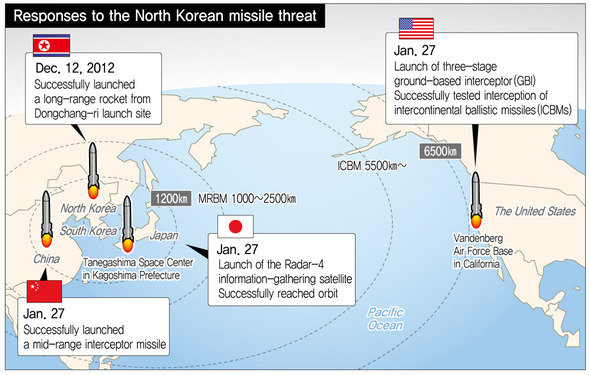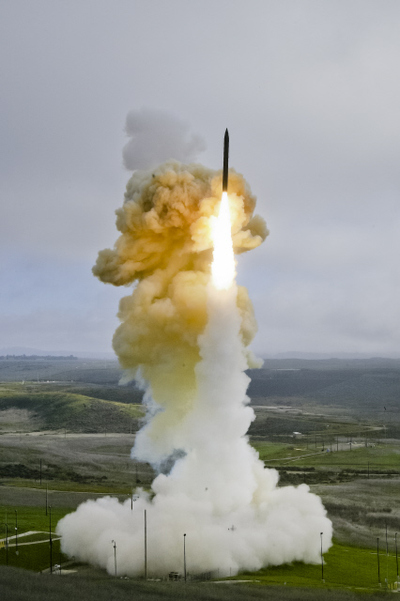Neighboring militaries preparing for North Korean threat

With North Korea declaring its intention to push ahead with a third nuclear test following the United Nations Security Council resolution on its launch of a long-range rocket, it seems hardly a coincidence that the US, China, and Japan have launched their own interceptor missiles and spy satellites. As the intensity of the North Korean nuclear crisis soars and the strategic competition between the US and China, and between China and Japan, heats up in the Asia-Pacific region, military tensions are on the rise in Northeast Asia.
On Jan. 26 (local time), the US Defense Department announced that it had succeeded in a test of a missile defense system that can intercept intercontinental ballistic missiles (ICBMs) that are aimed at the continental US while they are still outside the atmosphere. This test is part of a project that is being conducted to defend the continental US from the ICBM threat posed by North Korea and Iran.
The Missile Defense Agency (MDA), a section of the US Defense Department, said, “We were successful in our launch of a three-stage ground-based interceptor (GBI) from Vandenberg Air Force Base in California.”
The test was conducted as part of the development of the Ground-based Midcourse Defense (GMD). A ballistic missile’s trajectory is divided into the launch phase, a middle phase when it is in outer space beyond the atmosphere, and a final phase where it enters the atmosphere once again. GMD refers to intercepting a ballistic missile in this middle phase.
“We didn’t launch a real missile to serve as a target for the interceptor,” the MDA said. “However, if such a target missile had existed, the Exoatmospheric Kill Vehicle (EKV) that was attached to the interceptor rocket would have collided with the target and destroyed it.”
During a test launch by the MDA in Dec. 2010, the EKV failed to intercept the target. This test involved actually launching a target object and attempting to destroy it. The most recent test took place after correcting the flaws in the guided missile technology that became apparent in the former test.
China also succeeded in a test launch of a ground-based mid-range interceptor missile conducted inside its own territory on Jan. 27, the country’s news agency Xinhua reported on Jan. 28, quoting a Defense Ministry official. “The test launch achieved the goals that we had set. The test was defensive in nature and was not targeted at any country,” the official emphasized.
 |
|
A GBI interceptor missile is launched by the US Defense Department at Vandenberg Air Force Base in California, Jan. 27. The missiles are capable of intercepting intercontinental ballistic missiles (ICBMs) aimed at the continental US while still outside the atmosphere. (US Defense Department photo)
|
This is the second time that China has officially announced that it has conducted an interceptor missile test. On Jan. 11, 2010, China said that it had successfully completed the test of a mid-range interceptor missile. At the time, the US press saw this as China’s response to the US Defense Department’s decision to permit sales of the MIM-104 Patriot interceptor missiles to Taiwan.
The interceptor test is a response to US moves to establish a missile defense perimeter in East Asia, suggested Song Zhongping, who served as an instructor with China’s Second Artillery Force, the strategic missile unit of the People’s Liberation Army (PLA).
“If the US does not accelerate its movements to establish a strategic missile defense system in the East Asia and Pacific region, and if it doesn’t upset the strategic balance, China won’t need to conduct an interceptor missile test,” Song said in an interview with Fenghuang Satellite TV.
On Jan. 27, Japan launched the Radar-4 information-gathering satellite, which functions as a spy satellite, from the Tanegashima Space Center in Kagoshima Prefecture. Now that the satellite, delivered on an H-2A rocket, has entered its planned orbit, Japan’s surveillance network has expanded to five information-gathering satellites three optical satellites and two radar satellites that are capable of monitoring every spot on earth once each day. Japan’s development of information-gathering satellites was triggered by the 1998 launch of the Taepodong missile in 1998.
Called information-gathering satellites, in reality they are spy satellites. “The satellites circle the globe about ten times a day. If there is only one optical and one radar satellite, a blind spot forms. There have to be two each in order to get rid of this blind spot,” the Yomiuri Shimbun newspaper reported.
The day before North Korea’s long-range rocket launch took place on Dec. 12, 2012, Japanese satellites had detected the rocket being removed from the launcher. However, after that, the area moved into the blind spot, and Japan was not able to track any further movements, the newspaper reported.
With the satellite launch, which was the sixteenth consecutive successful launch of Japan’s H-2A rocket, the country proudly displayed its rocket technology, which uses liquid hydrogen fuel.
“It’s not yet clear whether the simultaneous launch of interceptor missiles and spy satellites by the US, China and Japan took into account North Korea’s recent statements about missile launches and nuclear tests,” said a diplomatic source in Beijing. “However, we will need to watch carefully to see whether the major powers neighboring the Korean peninsula will treat moves by the North as a pretext to take measures to strengthen their own military might.”
By Park Hyun, Park Min-hee and Jeong Nam-ku, Washington, Beijing and Tokyo correspondents
http://www.hani.co.kr/arti/english_edition/e_international/571778.html
